My wife (Joyce K0JJW)
and I were looking for a great place for an island vacation and someone
recommended
Bonaire as a quiet little island with world class diving and snorkeling. We
checked into it further and confirmed that this was a great place to spend 2
weeks just hanging out.
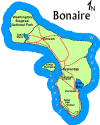 From
a ham radio perspective, Bonaire is part of
DXCC entity Netherlands
Antilles and operates under the
CEPT
licensing agreement. That is, US hams just need to carry the right documents
with them and just start operating. For Bonaire, the prefix is PJ4, so the
callsign I used was
PJ4/K0NR. This sort of Mini-DXpedition is always fun,
so I took along some HF equipment and a basic FM satellite station. Everything
had to be transported via airline, so the radio gear needed to be compact.
From
a ham radio perspective, Bonaire is part of
DXCC entity Netherlands
Antilles and operates under the
CEPT
licensing agreement. That is, US hams just need to carry the right documents
with them and just start operating. For Bonaire, the prefix is PJ4, so the
callsign I used was
PJ4/K0NR. This sort of Mini-DXpedition is always fun,
so I took along some HF equipment and a basic FM satellite station. Everything
had to be transported via airline, so the radio gear needed to be compact.
Let
me be clear...the main goal of this trip was to get up every morning and say
"hey, what, if anything, do we feel like doing today?" Hence, the term "mini" DXpedition.... I wasn't about to spend the entire time running pileups.
HF Station
The HF station was a Yaesu FT-100, Samlex switching power supply, MFJ antenna
tuner and a wire vertical antenna. I wanted to have PSK31 capability as I've
found that to be very effective when operating portable with a less than optimal
antenna. For PSK31, I packed along my HP/Compaq notebook computer running
MixW software, with a
RigExpert S/D interface. The
RigExpert interfaces connect to the computer via a USB port and emulate a
soundcard inside the interface box. This is a great improvement over wiring the
computer's sound card into the radio, since it avoids mixing the normal Windows
beeps and boops with the radio audio. It also minimizes the hassle of setting
sound levels for the radio and then having to adjust the levels for other
software applications. The S/D version of the RigExpert is very compact and gets
its power from the USB port, so you don't need an additional power connection.
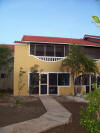 The
antenna was a vertical made of wire with four radials spread out on the ground.
I cut the vertical wire to be a 1/4-wave on 20M, since that was the band I
expected to be most productive. The MFJ tuner did a good job of keeping the
transceiver happy with the antenna on the other bands (17M, 15M and 10M). A
fiberglass fishing pole strapped to the trunk of a palm tree supported the
vertical wire in a very stealth fashion. We rented a one-bedroom condo at the
Sand
Dollar Resort and just discretely rigged the antenna outside our door. It
definitely got a few looks by the landscaping crew but they didn't seem too
concerned about it. (Click on the picture to the left to expand the view and you
might see the antenna.)
The
antenna was a vertical made of wire with four radials spread out on the ground.
I cut the vertical wire to be a 1/4-wave on 20M, since that was the band I
expected to be most productive. The MFJ tuner did a good job of keeping the
transceiver happy with the antenna on the other bands (17M, 15M and 10M). A
fiberglass fishing pole strapped to the trunk of a palm tree supported the
vertical wire in a very stealth fashion. We rented a one-bedroom condo at the
Sand
Dollar Resort and just discretely rigged the antenna outside our door. It
definitely got a few looks by the landscaping crew but they didn't seem too
concerned about it. (Click on the picture to the left to expand the view and you
might see the antenna.)
I had a terrible noise floor on 20M, so I only worked a few
stations there. Instead, I tended to work mostly PSK31 on 15 meters. This was
undoubtedly less productive than 20 meters would have been, but that's the way
it goes sometimes.
PJ4E
We had chosen the vacation time (late October, early November 2006) based on
my work schedule. As the time approached, I checked the various contest web sites
and discovered that the CQ
Worldwide DX Contest (Phone) was happening the weekend that we arrived. Not
only that, I found out that Phil N0KE was going to be operating the contest from
Bonaire with the PJ4E team. (I usually
work Phil during VHF contests here in Colorado.) They had
rented a station on the north
end of the island owned by Noah K2NG. We worked a few stations during the
contest, including PJ4E, but didn't seriously compete. The PJ4E team was
another story...those guys were in the contest for real and cranking out the QSOs.
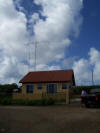 After
the contest, Joyce and I drove up to the PJ4E location but the crew was out
enjoying the island, so we missed them that day. See the picture of the station to the
left.
After
the contest, Joyce and I drove up to the PJ4E location but the crew was out
enjoying the island, so we missed them that day. See the picture of the station to the
left.
 I
wanted to leave them a note to tell them that we had stopped by, but discovered I didn't have a pen or paper to
write with. No problem, there was plenty of coral pieces laying around (the
whole island is made of coral), so I left a Morse Code message for them (see
photo at left). A few
days later, we did connect up with the PJ4E team and had dinner with them at a
local restaurant.
I
wanted to leave them a note to tell them that we had stopped by, but discovered I didn't have a pen or paper to
write with. No problem, there was plenty of coral pieces laying around (the
whole island is made of coral), so I left a Morse Code message for them (see
photo at left). A few
days later, we did connect up with the PJ4E team and had dinner with them at a
local restaurant.
OSCAR Grid Activation
I wanted to put Bonaire (grid FK52) on the air for satellite contacts.
The satellite station was a typical VHF/UHF FM portable station consisting of:
- Kenwood dualband HT (TH-79A)
- Arrow II 146/437 dualband antenna with built-in
duplexer
- Zen NanoPlus MP3 Player (for logging)
- Earbud headphones
 The
first problem I ran into was that AO-51 was configured in an interesting mode of
SSB uplink (146 MHz) and FM downlink (435 MHz). My little HT can't do SSB, so I
was locked out of AO-51 for the first week. In the second week of my trip, AO-51
was configured for 2.4 GHz uplink and 435 MHz downlink. OK, so I wouldn't be
using AO-51.
The
first problem I ran into was that AO-51 was configured in an interesting mode of
SSB uplink (146 MHz) and FM downlink (435 MHz). My little HT can't do SSB, so I
was locked out of AO-51 for the first week. In the second week of my trip, AO-51
was configured for 2.4 GHz uplink and 435 MHz downlink. OK, so I wouldn't be
using AO-51.
Fortunately, another VHF/UHF FM satellite, SO-50 was
available. In fact, it was really available. I had not been active on the
satellites for quite a while and my experience was that the FM birds were
usually jammed with activity. The first time SO-50 came over I didn't hear a
thing. I even wondered whether I had the satellite tracking software set
correctly. Daylight savings time had just changed in the US but Bonaire does not
change time, so I thought my PC might be off by an hour. “Let’s see the computer
thinks it is on mountain standard time but it is located in Bonaire and what is
the offset for UTC?” I fiddled with the software until I convinced myself that I
had the tracking software configured properly. I finally concluded that the
SO-50 was just not that busy…at least not on weekday afternoons in the southern
Caribbean.
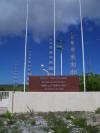 Bonaire is approximately 12 deg N latitude, near South
America, so US stations were only workable for a few minutes of a pass. Then I
realized that I normally rely on a signal on the downlink to adjust for doppler
shift and point the antenna. Without a signal, this became more difficult. (My
HT doesn't let me tweak the downlink frequency while transmitting.) The next
thing that happened was that I transmitted on the 2M uplink and heard terrible
interference on the downlink frequency. It sounded like a local broadcast
station was mixing with my uplink signal and showing up on the downlink
frequency. Uh, oh, this was really bad since it completely wiped out my ability
to listen to myself on the downlink. There were several broadcast stations on
the island, including Radio Netherland, but I did not verify the source of the
interference. Clearly, my poor little HT receiver couldn't handle it. I was
really surprised by this as I had previously operated from many locations using
this equipment without any problems. The interference problem was solved by
finding a good spot on the island that didn't have the interference. Presumably,
this was far enough away from the offending transmitter. I made a few skeds via
email and finally got going on SO-50.
Bonaire is approximately 12 deg N latitude, near South
America, so US stations were only workable for a few minutes of a pass. Then I
realized that I normally rely on a signal on the downlink to adjust for doppler
shift and point the antenna. Without a signal, this became more difficult. (My
HT doesn't let me tweak the downlink frequency while transmitting.) The next
thing that happened was that I transmitted on the 2M uplink and heard terrible
interference on the downlink frequency. It sounded like a local broadcast
station was mixing with my uplink signal and showing up on the downlink
frequency. Uh, oh, this was really bad since it completely wiped out my ability
to listen to myself on the downlink. There were several broadcast stations on
the island, including Radio Netherland, but I did not verify the source of the
interference. Clearly, my poor little HT receiver couldn't handle it. I was
really surprised by this as I had previously operated from many locations using
this equipment without any problems. The interference problem was solved by
finding a good spot on the island that didn't have the interference. Presumably,
this was far enough away from the offending transmitter. I made a few skeds via
email and finally got going on SO-50.
 There
was usually one or two good midday passes that worked out well as well as a few
nighttime passes. Stations worked were N3UNM, N4ZQ, N3PKC, W5ACM, XE2AT, XE2ISS,
XE1MEX, XE2YW, YV5DSL, YY5FRD and YV1DIG. For most of these guys, PJ4 was a new
country for them on satellite.
There
was usually one or two good midday passes that worked out well as well as a few
nighttime passes. Stations worked were N3UNM, N4ZQ, N3PKC, W5ACM, XE2AT, XE2ISS,
XE1MEX, XE2YW, YV5DSL, YY5FRD and YV1DIG. For most of these guys, PJ4 was a new
country for them on satellite.
One of the challenges with this kind
of operation has been the logging. In the past, I’d sometimes have someone jot
down the information on paper as I worked the various stations. This can be fast
and furious so it is easy to miss important information. A better approach is to
use a small cassette tape recorder to record the audio from the contacts. I
recently came across a nice upgrade to the audio tape recorder. Creative Labs
produces a very small MP3 player called the Zen Nano Plus that has a built-in
microphone and recording feature. I just clip this device onto my shirt as I
work the satellites, making comments about callsigns, grids, UTC, etc. into the
microphone. See my
blog posting on the Zeno Nano Plus for more information.
If you worked me and would like PJ4 confirmed, QSL to my home
callsign, K0NR, direct or via the bureau.
I have already uploaded the log into the ARRL
Logbook of the World.
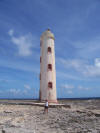 Enjoying
the Island
Enjoying
the Island
We went snorkeling every single day (and after every snorkeling trip we said
"this is the best yet!). There was so much to choose from and enjoy. We also saw
the wild donkeys....lots of wild donkeys.... pink
flamingos...lighthouses...great restaurants. The feel of the island was
perfect....very laid back but still functional.
 Joyce
and I are ready to go back to Bonaire. You can't beat a vacation that has island
time, snorkeling and ham radio!
Joyce
and I are ready to go back to Bonaire. You can't beat a vacation that has island
time, snorkeling and ham radio!
 The KØNR Radio
Site
The KØNR Radio
Site